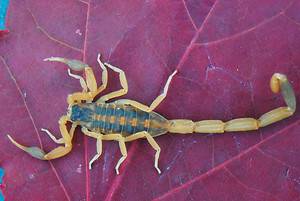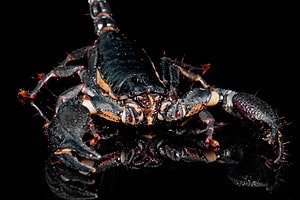Many people deem scorpions as one of the most interesting members of the class Arachnida owing to their formidable looks, pincer-like pedipalps, and segmented tails that hold their telsons or stingers. A larger majority is reasonably frightened by these creatures, even more than their nearsighted relatives, the spiders.
Did you know that cutting off a scorpion’s tail is one of the easiest ways to kill it? The tail hosts the arachnid’s anus, located near the stinger; without it, therefore, it gradually dies from constipation. Nonetheless, the species come in different sizes, with some as small as half an inch and others an entire unit measuring nearly ten inches.
In this article, we’ll look into the largest scorpion in the world and offer additional information about these captivating animals older than the extinct dinosaurs.
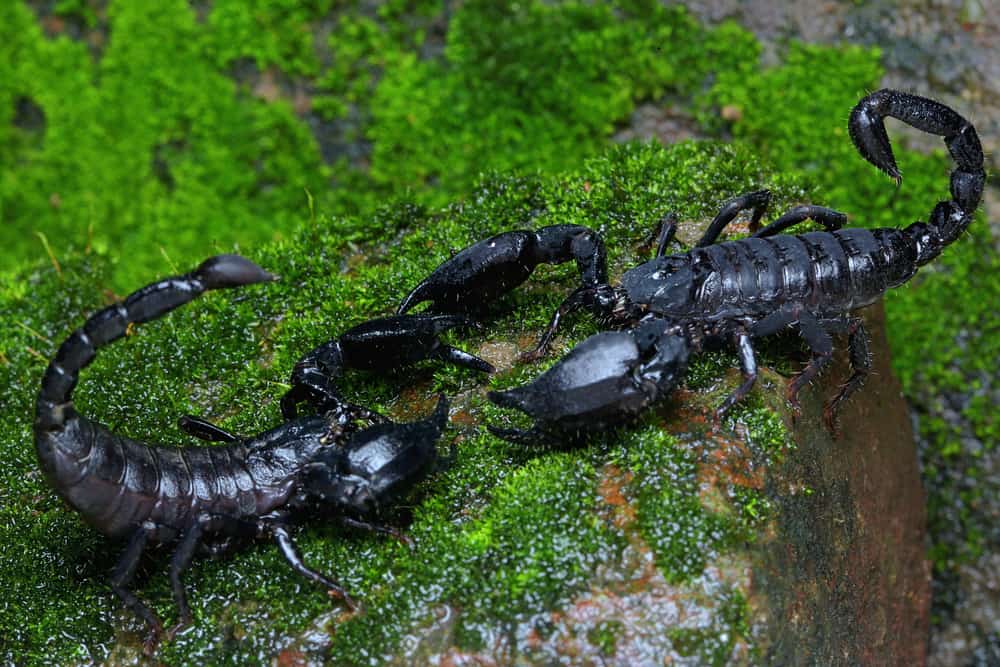
The colossal wonder of the largest scorpion in the world, known for its remarkable size and striking features.
©I Wayan Sumatika/Shutterstock.com
Which is the Largest Scorpion in the World?
The giant forest scorpion (Gigantometrus swammerdami) is the world’s largest scorpion. It’s a member of the family Scorpionidae and boasts a length of up to 9.1 inches. Adults weigh about 2 ounces – the same as a tennis ball – reaching maturity in only 1-3 years.
Giant forest scorpions are native to India. They come with large food-handling pincers and shiny black but sometimes reddish-brown exoskeletons that glow gray-green under ultraviolet (UV) light. Besides, these intriguing arachnids are solitary and only make an exception to interact with others during the mating season in the summer.
Like bats, giant forest scorpions are nocturnal. They spend much of their nighttime scouring their habitats for food or digging burrows underground. Their diet mainly includes small insects like locusts, and other invertebrates, including crickets and mealworms.

Here are six more facts to know about giant forest scorpions:
1. They Have 16-20 Pectines
Giant forest scorpions have 16-20 pectines, or comb-like limbs, that are handy in various situations, including grooming. In addition, they help the arachnids know their surroundings by enabling them to detect physical and chemical stimuli and translate them to the brain.
2. They Have Poor Vision
Despite being the largest scorpion species, giant forest scorpions have extremely poor eyesight. Thankfully though, they have hairs all over their bodies to help them navigate their way by picking up vibrations around them.
3. They Prefer Other Animals’ Homes
More often than not, giant forest scorpions live in tropical forests in India. However, they’re not always in their homes as they like inhabiting other animals’ shelters. Therefore, you’ll likely find them in crab holes, rat caves, and even termite mounds.
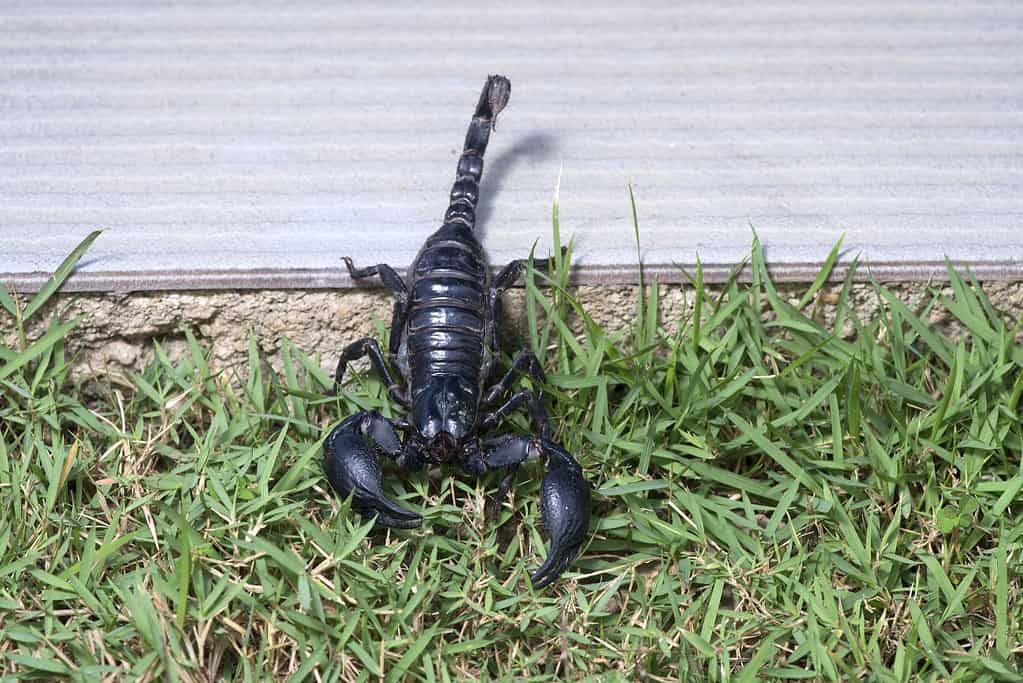
Unveiling the remarkable behavior of scorpions: they have a surprising affinity for making themselves at home inside other insects’ burrows.
©iStock.com/ApisitWilaijit
4. They’re Friendlier Than Other Scorpions
Many people fear the giant forest scorpion because of its colossal size. Surprisingly, it’s among the most docile scorpion species, explaining why others keep it as a pet. Moreover, its venom isn’t lethal to most humans and other animals, except smaller creatures.
Nevertheless, giant forest scorpions will retaliate if attacked or threatened. The large arachnids use their tails and claws to defend themselves by pinching the enemy, only leveraging their telsons as a last resort.
5. They Have Interesting Mating Rituals
Giant forest scorpions may not even be remotely related to alligators, but the two animals have one thing in common — their intriguing mating rituals. These arachnids dance before copulation, with the males clutching the females’ pincers to move around for a while.
Male giant forest scorpions make some of the most important decisions involved in mating, including where to deposit their sperm sac. They then direct the females to the same location for internal fertilization.
The giant forest scorpion’s gestation period is usually between 5 and 8 months, with factors like temperature and food availability determining how soon they give birth. The females carry the scorplings until their embryonic yolk sacs are depleted. As soon as the young arachnids shed their first exoskeletons, they leave their mothers to fend for themselves.
6. They’re at Risk
The International Union for Conservation of Nature (IUCN) hasn’t declared the giant forest scorpion endangered. Nevertheless, the species is a victim of the illegal pet trade, which has massively affected its population because some keepers will do anything to secure it, owing to its easygoing nature.
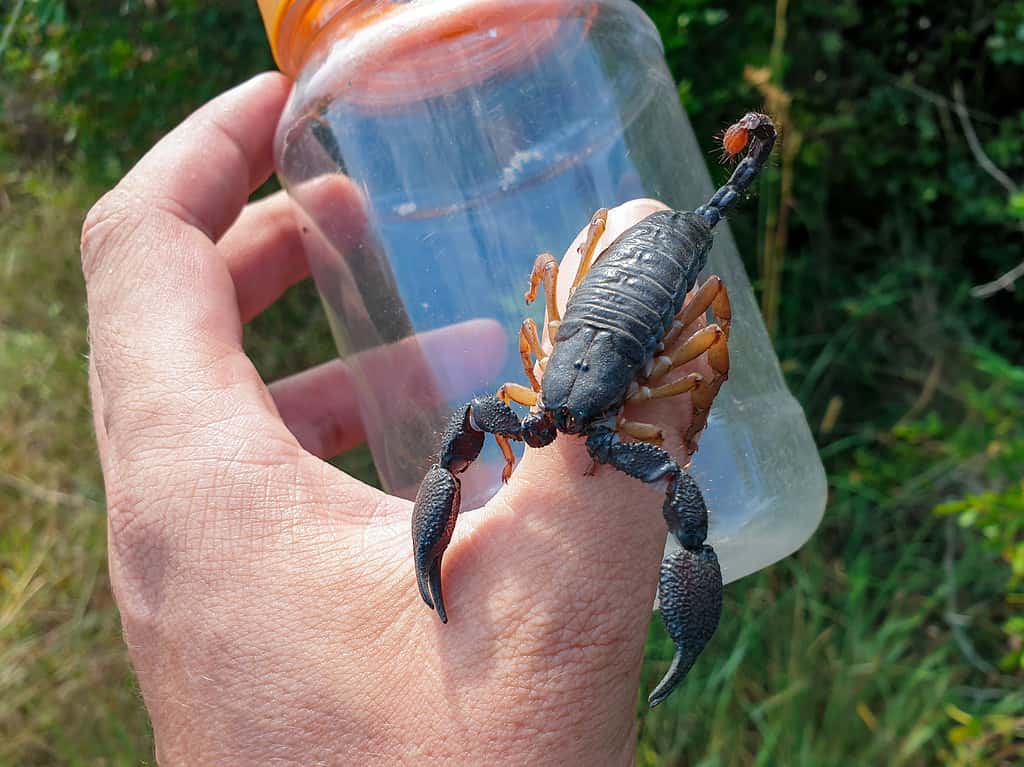
Scorpions, resilient creatures of the wild, are facing increasing risks in their natural habitats. Environmental changes and human activities threaten their existence.
©iStock.com/Willem Van Zyl
Is the Giant Forest Scorpion the Asian Forest Scorpion?
Countless people have – for the longest time – considered the giant forest scorpion the same as the Asian forest scorpion. After all, they are both mainly found in Asia and look pretty much alike. However, these two creatures are different, hence our appreciation for scientific names in the first place!
So, while the giant forest scorpion is the Gigantometrus swammerdami, the Asian forest scorpion is the Heterometrus spinifer, only reaching lengths of 3.5-5 inches. The latter is among the most common scorpion species kept as pets.
If you’re considering keeping an Asian forest scorpion, consider these valuable tips:
- Keep each Asian forest scorpion alone, as the species is territorial and defensive.
- Handle your scorpion pet regularly to reduce its aggressiveness when you pick it up.
- Provide a spacious terrarium or enclosure, preferably 300 by 300 by 300 millimeters.
- Maintain the animal’s carnivorous diet of insects and invertebrates.
- Maintain an air temperature of 70-75 degrees Fahrenheit.
- Provide several hiding places like logs and rocks.
- Clean its enclosure regularly to keep parasites at bay.
Other Popular Scorpion Species
Apart from the giant forest scorpion and the Asian forest scorpion, the world hosts nearly two thousand other scorpion species. Here are some that may not be on your radar yet:
1. Emperor Scorpion
Often reaching lengths of about 7.9 inches, the emperor scorpion is among the larger scorpion species. It’s native to West Africa, preferring to occupy rainforests and savannas in countries like:
- Senegal
- Ivory Coast
- Ghana
- Sierra Leone
- Benin
- Burkina Faso
Like its venomous brothers and sisters, the sizeable emperor scorpion is active at night when it hunts its prey, using its large claws to capture it. The arachnid’s diet includes small animals like fruit flies and crickets. However, the arachnid is a picky eater and tends to consume other creatures, including scorpions and larger vertebrates such as lizards.
An emperor scorpion has a distinct glossy black or dark brown body that glows blue under UV light. On the other hand, its stinger and claws boast a red hue, which sometimes grows darker after each molt. Most people can’t tell the males and the females apart because they appear similar, except that the latter is a tad larger than the former.
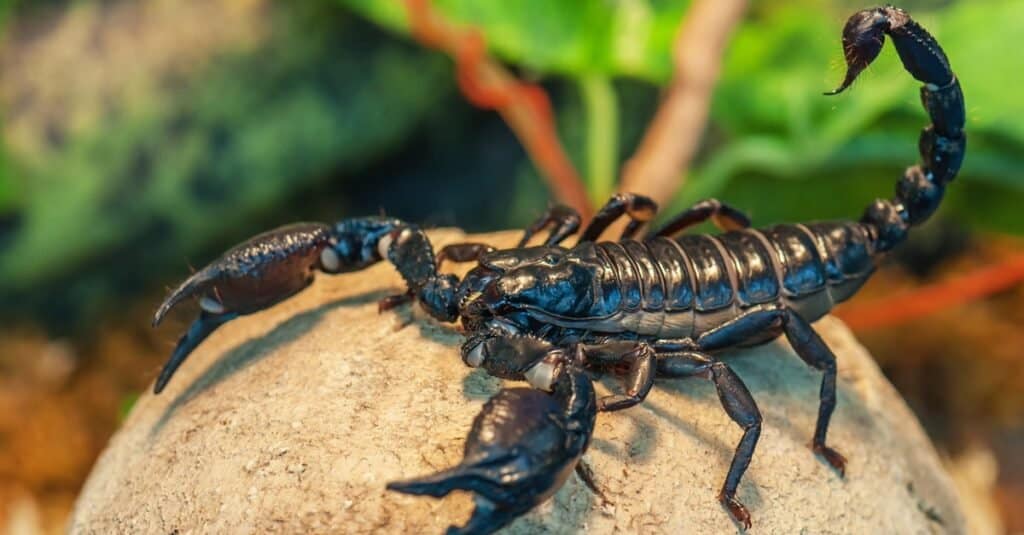
Meet the emperor scorpion, the charismatic ruler of the arachnid world. With its imposing size, dark exoskeleton, and impressive pincers, this magnificent creature commands attention.
©Vova Shevchuk/Shutterstock.com
2. The Deathstalker
The deathstalker belongs to the family Buthidae and is among our planet’s most lethal scorpions, owing to its tail jam-packed with potent venom. Its sting causes extreme pain, swelling, and even paralysis, though it’s unlikely to kill a healthy adult human.
The deathstalker mainly lives in North African arid areas, including the vast Sahara Desert. You’ll also find it in countries like Sudan, Niger, Somalia, and many Middle Eastern regions such as Iran, Yemen, and Turkey. While it likes occupying man-made structures like houses and sheds, the deathstalker doesn’t mind nesting under rocks and fallen trees.
The deathstalker has a yellow body with a dark brown abdomen. The creature’s tail features its most unique aspect — the dark segment below the stinger, though it might be hard to notice unless you observe it closely. Nonetheless, don’t throw caution out the window when you see this species because it has a fast speed of up to 3 mph and will sting you before you even know it.
3. Stripe-Tailed Scorpion
The stripe-tailed scorpion, otherwise called the wood scorpion or devil scorpion, is a species found in Arizona and some parts of California and New Mexico. Although it mainly lives in arid areas, it’s common to see it in homes; it enters the structures through crevices to search for shelter or prey and hides in bags, shoes, and other humid areas within the property.
Like its relatives, the stripe-tailed scorpion’s tail holds venom. But it barely affects humans or animals, making it a favorite for keepers who fancy the species. Some of the animals that prey on this arachnid are:
Unlike the deathstalker and emperor scorpion, the devil scorpion is small and only grows 2-3 inches long. Its body is dark brown or tan, with brownish-tan stripes running across its back.
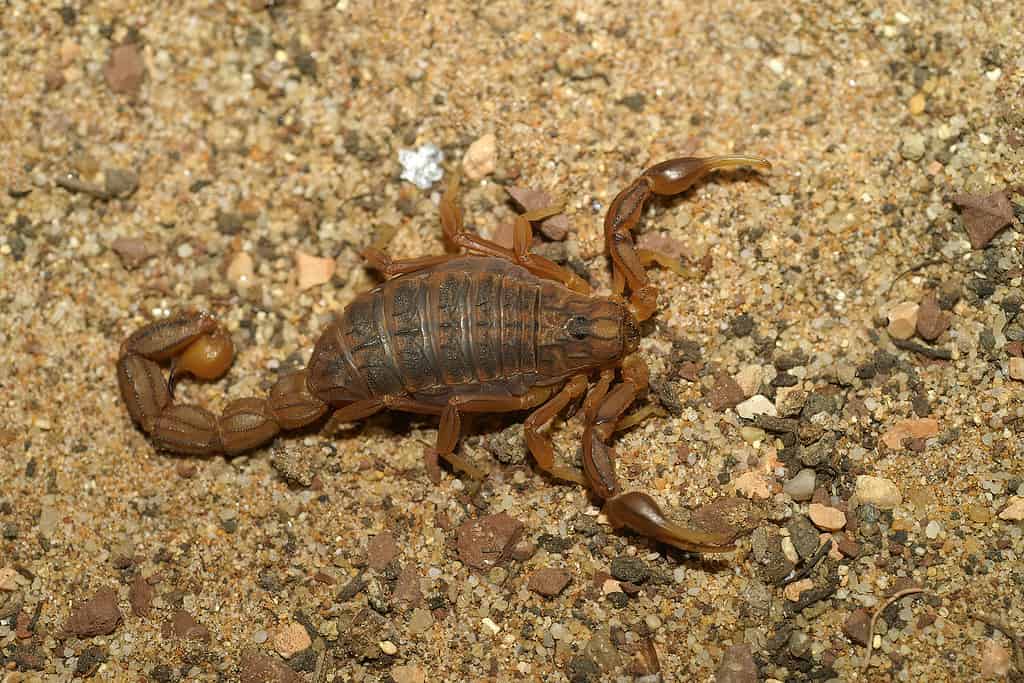
The mesmerizing stripe-tailed scorpion is known for its striking appearance and captivating characteristics. With its vividly striped tail and venomous stinger, this arachnid exhibits an intriguing blend of beauty and danger.
©iStock.com/Wirestock
4. European Yellow-Tailed Scorpion
You can’t miss the yellow-tailed scorpion with its black body, yellow-brown tail, and legs. Though native to Northwest Africa and Southern Europe, it also occupies different parts of Britain, where it’s believed to have arrived in the 19th century.
Yellow-tailed scorpions like tropical climates, choosing to live in holes and cracks in walls. While its venom isn’t fatal to healthy adults, it can quickly kill seniors or infants. But still, the arachnids are a favorite for keepers looking for small, manageable pets because they only grow to about 1.4-1.8 inches long.
Moreover, the yellow-tailed scorpion carries its young for 14 months at most, contrary to some species whose gestation periods of up to 18 months. If the arachnid is in a warm temperate region with plenty of food, it might even give birth after only ten months. The scorplings reach adulthood in one or two years and live for about five years, which is the species’ lifespan. It’s the main aspect that appeals to keepers seeking short-term commitments.
5. Indian Red Scorpion
The Indian red scorpion, also known as the eastern Indian scorpion, only grows 2-3.5 inches long. But don’t let its small size fool you — it’s among the world’s deadliest scorpions, having already claimed several lives in Jaffna and other parts of the world. Therefore, treat its sting as a medical emergency.
The Indian red scorpion’s venom comprises a mix of proteins, peptides, and salts that may trigger some of these symptoms:
- Swelling around the stung area
- Unimaginable pain
- Shock
- Breathlessness
- Pink frothy sputum
- Change of skin color to bluish-purple
- Vomiting
- Excessive sweating
Interestingly, the Indian red scorpion isn’t always red, although its name suggests otherwise; it can also be orange or reddish brown. A large population of these dangerous arachnids inhabits India, and its neighbors, including Pakistan, Sri Lanka, and Nepal.
6. Arizona Bark Scorpion
The Arizona bark scorpion has also clinched a spot on the world’s most lethal scorpions list. Its sting triggers severe pain lasting up to 72 hours, a period that sees the victim experience other devastating symptoms, such as numbness, vomiting, convulsions, and shortness of breath.
Sadly, the Arizona bark scorpion has claimed several lives in Arizona, where it’s estimated to sting thousands of people yearly. Moreover, this species also inhabits parts of California and New Mexico. Thanks to its light brown body, you can easily identify it. However, you might not spot it soon enough to escape because it’s small, with a length of roughly 3.1 inches.
Intriguingly enough, not all animals are affected by the Arizona bark scorpion’s venom. For example, grasshopper mice exhibit zero symptoms after the arachnid’s sting, explaining why the rodents prey on it. More of this scorpion’s predators are owls, pallid bats, snakes, spiders, and peccaries. Its population is also affected by the pet trade, and scientists are capturing it for studies.
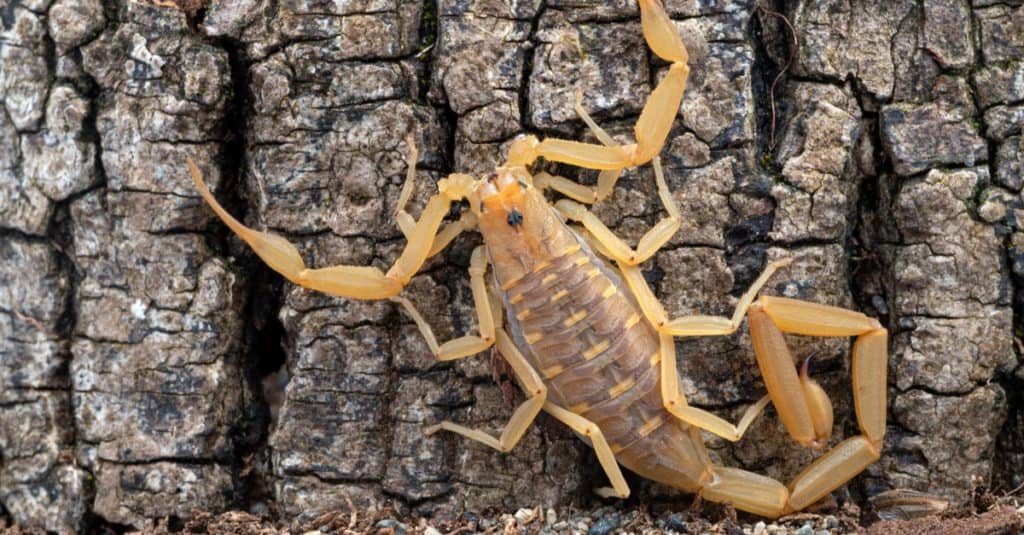
The Arizona bark scorpion is a venomous arachnid found in the southwestern United States. With its slender body, elongated tail, and formidable pincers, this scorpion commands respect.
©Ernie Cooper/Shutterstock.com
7. Brazilian Yellow Scorpion
The Brazilian yellow scorpion is another venomous species you should beware of, with a mortality rate of roughly 1-2% among seniors and kids. Only recently, in 2022, the arachnid stung 7-year-old Luiz Miguel Furtado Barbosa, who died two days later from multiple cardiac arrests.
As its name suggests, the Brazilian yellow scorpion is native to Brazil and is found across regions such as:
- Bahia
- Santa Catarina
- Espírito Santo
- Alagoas
- Mato Grosso
- Pernambuco
- Sergipe
- Paraná
- Goiás
Regrettably, factors like deforestation and urbanization have seen the Brazilian yellow scorpion population increase rapidly within the past few years. Moreover, this species boasts a low metabolic rate that enables it to survive a long time on an empty stomach, meaning it’s even likely to inhabit places without its favorite food option — insects.
8. Desert Hairy Scorpion
The desert hairy scorpion may not be the world’s largest scorpion species, but it’s North American largest one, growing up to 5.5 inches long. While its tail has venom, it’s not fatal, meaning its sting rarely causes severe symptoms. However, if you’re allergic, you may experience difficulty breathing and pain for several hours. Plus, the stung part of your body will likely swell.
As its name hints, the desert hairy scorpion has brown hairs covering its yellow body. Although the males have larger pincers, the females have a stockier, wider build. Both genders have a penchant for burrowing and prefer living under rocks or moist areas. These species are mainly found in California, the Mojave Desert, the Sonoran Desert, and some parts of Nevada and Utah.
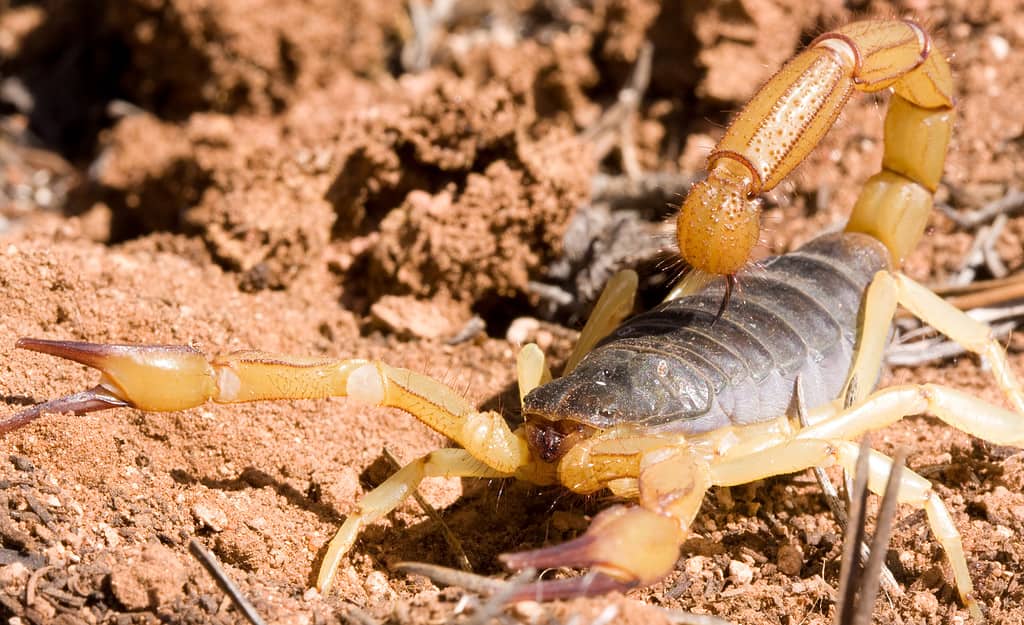
Meet the desert hairy scorpion, an arachnid adapted to thrive in arid desert environments. With its hairy body, strong pincers, and potent venom, this scorpion exemplifies survival in harsh conditions.
©Dave Rock/Shutterstock.com
Protect Large and Small Scorpion Species
We hope our comprehensive guide has provided much-needed insight into the largest scorpion in the world and others inhabiting our planet. While most of these intriguing creatures are venomous, they’re still an important part of the ecosystem as they help to regulate pest populations.
We recommend you let scorpions be if you run into them in the wild. If they invade your home, don’t hesitate to kill them or call an exterminator to do the job. However, you can still get one of these species as a pet if you’re fond of arachnids. Do your homework before taking any of them home; it will help you know if it’s venomous and learn the best care practices.
The photo featured at the top of this post is © Valt Ahyppo/Shutterstock.com
Thank you for reading! Have some feedback for us? Contact the AZ Animals editorial team.




